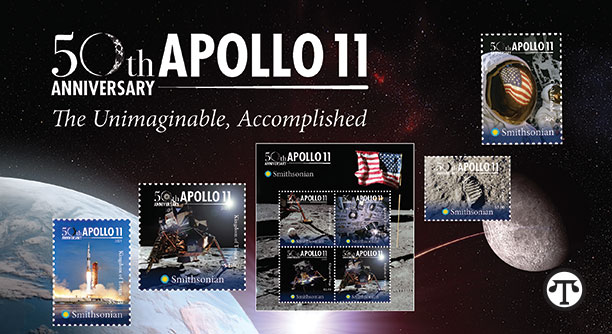An Out-Of-This-World Collectors’ Edition

(NAPSI)—It was “One small step for man, one giant leap for mankind,” when Neil Armstrong and Buzz Aldrin walked on the Moon. Now, half a century after the first Moon landing, you can hold some of the wonder of it all in your hand with a set of commemorative stamps.
In collaboration with the Smithsonian’s National Air and Space Museum, Philatelic Mint has developed a collection consisting of 27 postage stamps issued from the Cook Islands and the Kingdom of Tonga. They’re treated with blue phosphor ink that glows under UV light.
As the world’s largest museum and research complex, Smithsonian brings unique stories to life for you and your family through officially licensed products like these.
This stunning limited-edition collection by Philatelic Mint comes with a presentation folder that is 11 inches tall and 6.5 inches wide when closed and that opens to a breathtaking spread over 3 feet wide.
What’s more, a limited number of the commemorative stamps first issued in July 1969 by the U.S. Postal Service to honor the event, picturing mission commander Neil Armstrong planting the U.S. flag on the lunar surface, are also available.
Other Collections
If getting the Moon isn’t enough, Philatelic Mint plans many other collections of elegant, timeless stamps featuring scores of fascinating topics. For example, there will be a set on the history of space, one featuring animals from the National Zoo and Conservation Biology Institute, and many more. Subscribers will get new sets of stamps from countries all over the world, on topics both familiar and new.
In fact, Philatelic Mint is dedicated to bringing entertaining collections of stamps and related material to a growing public of subscribers and collectors. The stamps can be a treasure for you and your family for many years to come.
Why Collect Stamps
Stamp collecting helps the collector learn about geography, biography, history, culture and art. Stamps are miniature gateways to the world.
How to Collect Stamps
You don’t have to buy expensive equipment to enjoy stamp collection, but one essential rule to remember is that the condition of a stamp is a very important consideration. Badly torn and mishandled stamps are not only unpleasant to the eye, they’re worth next to nothing when compared to their undamaged counterparts. Try to acquire the finest possible specimens for your collection.
Because their condition is so important (and stamps are only bits of paper, after all), handle them with care—and perhaps a pair of tongs.
Because stamps are small, it’s often difficult to see all their minute detail with the naked eye. Magnifying glasses can help you not only see the design better but, in some instances, discover small details that distinguish one stamp from another. Sometimes, when stamps appear to be the same, they’re not.
Learn More
For further facts, a look at the latest collections and information on how to subscribe, go to www.pmintstamps.com or mail to P.O. Box 3162, Sag Harbor, NY, 11963.

“Half a century after the first Moon landing, you can hold some of the wonder in your hand with a set of commemorative stamps developed in collaboration with the Smithsonian’s National Air and Space Museum and Philatelic Mint. http://bit.ly/2m0IvVb”
